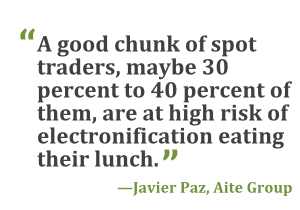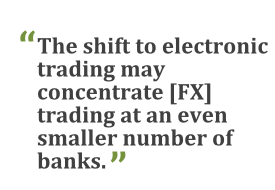A widening probe of the foreign-exchange market is roiling anindustry already under pressure to reduce costs as computer platforms displace human traders.
|Electronic dealing, which accounted for 66 percent of allcurrency transactions in 2013 and 20 percent in 2001, will increaseto 76 percent within five years, according to Aite Group LLC, aBoston-based consulting firm that reviewed Bank for InternationalSettlements data. About 81 percent of spot trading—the buying andselling of currency for immediate delivery—will be electronic by2018, Aite said.
|“Foreign-exchange traders are much like stock floor traders: arapidly dying breed,” said Charles Geisst, author of “Wall Street:A History” and a finance professor at Manhattan College inRiverdale, New York. “Once the banks realize they are costing themmoney, the positions will dwindle quickly.”
At least a dozen regulators are investigating allegationsfirst reported by Bloomberg News in June that traders colludedto rig benchmarks in the $5.3 trillion-a-day currency market. Thatscrutiny may give banks an opportunity to cull more staff, say analysts including Christopher Wheeler ofMediobanca SpA in London. It's also boosting demand from clientsfor greater transparency in pricing and transaction charges,accelerating a longer-term shift in trading onto electronicplatforms.
|“The margins are very, very skinny in foreign exchange becauseit's easy to move onto a trading platform,” said Wheeler, whotracks European lenders. “The move by banks into electronic tradingin other areas has cost a large number of jobs, and we've seenrevenue come off sharply. The foreign-exchange probe won't helpthis.”
|The push toward electronic trading probably will lower costs forcustomers and boost transparency of pricing, according to CormacLeech, an analyst at Liberum Capital Ltd. in London. It may alsosqueeze margins for banks, he said.
|Information Advantage
|Human traders have maintained their role in the foreign-exchangemarket while disappearing in areas such as equities because mosttrading takes place away from exchanges. That means clients don'thave a central repository showing the flow of completed orders,forcing them to piece together information about the direction ofrates from traders and salesmen with knowledge of other clients'orders. People were also needed because early computerized tradingsystems weren't reliable and couldn't handle larger transactions,according to dealers.
|“Many algorithms in previous foreign-exchange platforms werevery, very basic—not a lot more than egg timers,” Chris Purves,London-based global head of foreign-exchange, rates, and creditelectronic trading at UBS AG, said in an interview. “The equitiesworld, on the other hand, had advanced algorithms with gamingtechnology inside of them; they would randomly split up clip sizesto provide best execution. A lot of that technology has now beenbrought into the foreign-exchange world.”
|Deutsche Bank AG, Citigroup Inc., Barclays Plc, and UBS AG arethe four biggest currency-trading banks, according to a May surveyby Euromoney. The investigation of alleged manipulation already isreducing the number of spot traders at these and other firms. Atleast 21 traders have been fired or suspended as a result of the probe. Some are leaving of their own volition. Banks including UBS, GoldmanSachs Group Inc., and Citigroup have banned dealers from using multiparty chat rooms.
|Firms such as London-based Barclays have started to cutemployees amid a wider squeeze in revenue from fixed income,currencies, and commodities, according to people with knowledge ofthe matter who asked not to be identified because they weren'tauthorized to speak publicly.
|“A handful of traders in a few banks have a huge informationadvantage they can transform into profits,” said Andre Spicer, aprofessor at Cass Business School in London. “They know what orderflows are, and research shows order flow is one of the few decentpredictors of price in this market. Ongoing inquiries may erodethis information advantage by restructuring the market. This willkill off opportunities for relatively easy profit.”
||Banks' income from foreign exchange already has been squeezed.Volatility, a key driver of revenue, is declining as concern thatEurope's sovereign-debt crisis would trigger the breakup of theeuro eased and central banks provided unprecedented liquidity tostabilize markets.
|Deutsche Bank's Currency Volatility Index, which measures themarket's expectation of future price swings for nine currencypairs, slumped to 7.53 percent on Feb. 17. The index was as high as15.8 percent in September 2011.
|Crimping Revenue
|That decline is crimping revenue at firms including Citigroupand UBS. New York-based Citigroup said last month that revenue inits rates and foreign-exchange business was down slightly in thefourth quarter from the previous period. UBS said this month thatforeign-exchange revenue declined in the fourth quarter because of“lower liquidity and reduced client risk appetite.”
Regulators are helping push more trading away from humans toelectronic platforms by making some transactions more expensive forbanks. The latest rules from the Basel Committee on BankingSupervision will make foreign-exchange derivatives—contracts withvalues derived from changes in currency rates—less attractive forbanks by imposing charges for holding positions and products thataren't cleared through exchanges.
|“No matter how you slice it, foreign-exchange options will bemore expensive for clients to trade and for banks to take on,” saidKevin McPartland, head of market-structure research at consultingfirm Greenwich Associates. “Shrinking profits from higheroperational costs and the increased cost of capital may cause banksto focus on generating revenue from their traditional cash businessand redirect money into technology that facilitates trading throughan agency model.”
|European regulators are also pushing firms to move more currencytrading onto regulated exchanges to boost transparency. GermanDeputy Finance Minister Michael Meister this month gave his backingto such an overhaul after it was suggested in January by Bafin, thecountry's financial regulator.
|The Basel rules are spurring the development of a currencyfutures market, based on exchanges. In 2005, the volume of suchfutures traded on the Chicago Mercantile Exchange was less thanone-third of daily spot trading on EBS, an electronic tradingplatform owned by ICAP Plc. In 2013, CME surpassed EBS for thefirst time, and by December, the volume of futures traded on theCME was almost 30 percent greater than that logged through EBS.
|'Clear Shift'
|“The aggressive growth of the futures model demonstrates a clearshift in the landscape, with market participants looking atalternative sources of liquidity and hedging tools alongside theover-the-counter market,” said Derek Sammann, a managing directorat the CME.
|Two of the biggest currency-trading banks are taking differentapproaches to defend their share of the market. Barclays hasdeveloped an addition to its electronic platform that gives clientsforeign-exchange rates aggregated from external sources.Zurich-based UBS is trying to retain the human element in itsplatform, allowing clients to connect directly with its sales andtrading desks, in addition to accessing research covering fixedincome, credit, equities products and foreign exchange.
|Barclays, the U.K.'s second-largest bank by assets, last yearstarted Gator, which allows clients to trade foreign exchange withthe same technology its traders already used internally to quoteprices. Gator, an extension of Barclays's earlier BARX platform, isthe first offering from an investment bank to aggregate currencyprices from external sources such as EBS, Currenex, and FXall,which is owned by Thomson Reuters. EBS was started by a group ofbanks in 1990 before being acquired by ICAP, the world's largestinterdealer broker, in 2006.
||Officials at Barclays, Deutsche Bank, and Citigroup declined tocomment on their trading operations. Bloomberg LP, the parentcompany of Bloomberg News, competes with Thomson Reuters and EBS inproviding news, information and currency-trading systems.
|In October, Switzerland's largest bank started UBS Neo, aplatform that replaced almost 100 internal systems with one thatallows institutional clients to trade a range of asset classes. Thesystem, which enables clients to connect with traders andsalespeople, mimics the way Twitter lets users to follow oneanother.
|While the system uses computer algorithms to complete clientorders, a service for which clients once relied on dealers'judgment, some trades are still passed on to the dealing desk inZurich. The firm still has about 25 spot currency traders, said aperson with knowledge of the matter.
|Electronification Risk
|About 70 percent of Barclays's trading is electronic today,compared with less than half when it opened its first currencyplatform in 2005, according to a person with knowledge of thematter who asked not to be identified because he wasn't authorizedto speak publicly.
|“A good chunk of spot traders, maybe 30 percent to 40 percent ofthem, are at high risk of electronification eating their lunch,”said Javier Paz, senior analyst at Aite.
|A decade ago, France's BNP Paribas SA employed about 15 spottraders and one electronic foreign-exchange team member in Paris.Today, the team has moved to London and includes six spot tradersand eight people dealing with electronic trading, according aperson with knowledge of the matter.
|The shift to electronic trading may concentrate trading at aneven smaller number of banks, forcing out competitors with a lowermarket share, according to Chirantan Barua, an analyst at SanfordC. Bernstein Ltd. in London. Some firms also may move toward theequities sales-trader model, where salesmen handle orders as wellas provide market information.
|“The old model is going away,” said John Taylor, founder of NewYork-based FX Concepts LLC, once the world's biggest currency hedgefund before it went bankrupt last year. “But it's better to say theold model has gone away several times. This is just the latest ofthose times.”
|Copyright 2018 Bloomberg. All rightsreserved. This material may not be published, broadcast, rewritten,or redistributed.
Complete your profile to continue reading and get FREE access to Treasury & Risk, part of your ALM digital membership.
Your access to unlimited Treasury & Risk content isn’t changing.
Once you are an ALM digital member, you’ll receive:
- Critical Treasury & Risk information including in-depth analysis of treasury and finance best practices, case studies with corporate innovators, informative newsletters, educational webcasts and videos, and resources from industry leaders.
- Exclusive discounts on ALM and Treasury & Risk events.
- Access to other award-winning ALM websites including PropertyCasualty360.com and Law.com.
*May exclude premium content
Already have an account? Sign In
© 2024 ALM Global, LLC, All Rights Reserved. Request academic re-use from www.copyright.com. All other uses, submit a request to [email protected]. For more information visit Asset & Logo Licensing.







